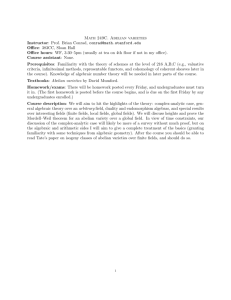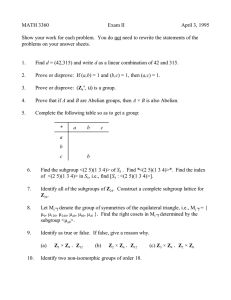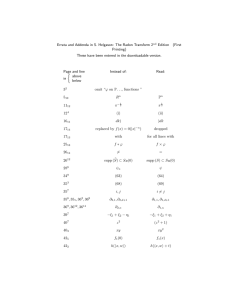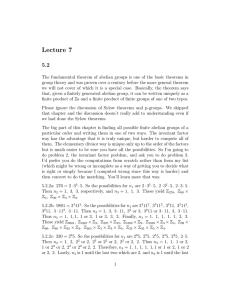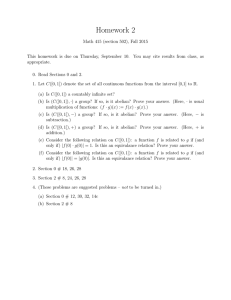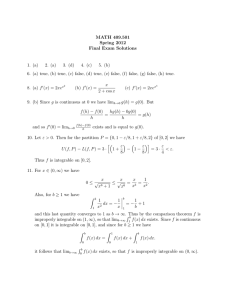THE COMPLEX GEOMETRY OF AN INTEGRABLE SYSTEM
advertisement
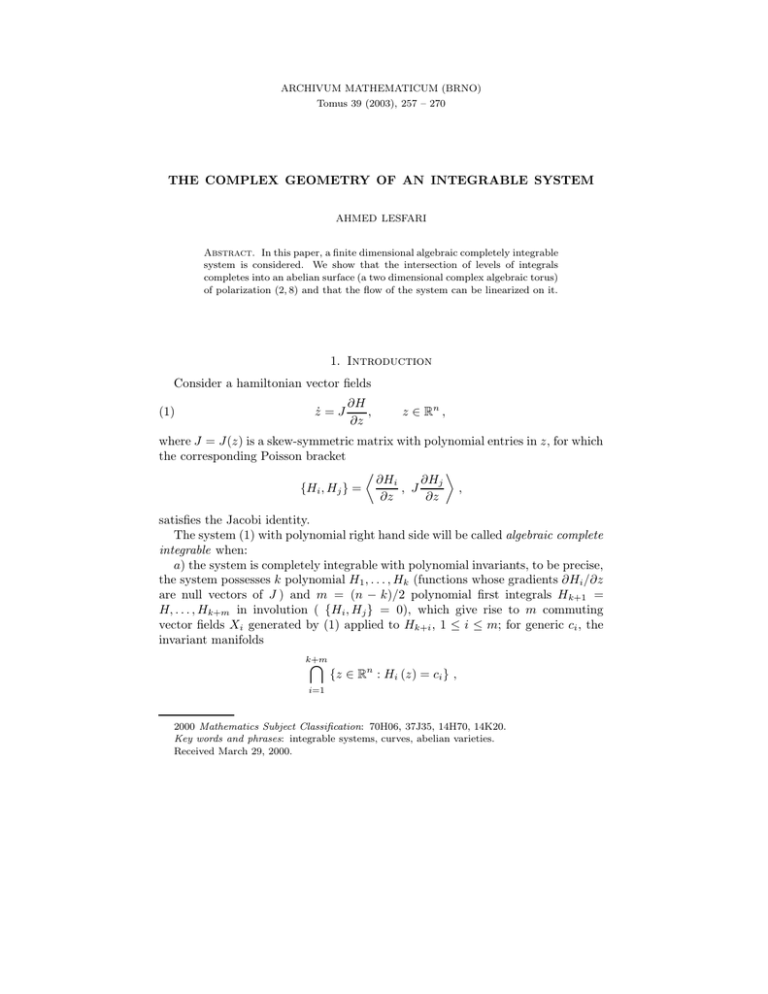
ARCHIVUM MATHEMATICUM (BRNO)
Tomus 39 (2003), 257 – 270
THE COMPLEX GEOMETRY OF AN INTEGRABLE SYSTEM
AHMED LESFARI
Abstract. In this paper, a finite dimensional algebraic completely integrable
system is considered. We show that the intersection of levels of integrals
completes into an abelian surface (a two dimensional complex algebraic torus)
of polarization (2, 8) and that the flow of the system can be linearized on it.
1. Introduction
Consider a hamiltonian vector fields
(1)
ż = J
∂H
,
∂z
z ∈ Rn ,
where J = J(z) is a skew-symmetric matrix with polynomial entries in z, for which
the corresponding Poisson bracket
∂Hj
∂Hi
,
, J
{Hi , Hj } =
∂z
∂z
satisfies the Jacobi identity.
The system (1) with polynomial right hand side will be called algebraic complete
integrable when:
a) the system is completely integrable with polynomial invariants, to be precise,
the system possesses k polynomial H1 , . . . , Hk (functions whose gradients ∂Hi /∂z
are null vectors of J ) and m = (n − k)/2 polynomial first integrals Hk+1 =
H, . . . , Hk+m in involution ( {Hi , Hj } = 0), which give rise to m commuting
vector fields Xi generated by (1) applied to Hk+i , 1 ≤ i ≤ m; for generic ci , the
invariant manifolds
k+m
\
i=1
{z ∈ Rn : Hi (z) = ci } ,
2000 Mathematics Subject Classification: 70H06, 37J35, 14H70, 14K20.
Key words and phrases: integrable systems, curves, abelian varieties.
Received March 29, 2000.
258
A. LESFARI
are compact and connected and therefore there exists a diffeomorphism
k+m
\
i=1
{z ∈ Rn : Hi (z) = ci } −→ Rm /Lattice
(real tori) ,
according to the Arnold-Liouville theorem [3, 18].
b) The invariant manifolds, thought of as affine varieties in Cm (non-compact)
A=
k+m
\
i=1
{z ∈ Cn : Hi (z) = ci } ,
e (abelian varieties) as follows
can be completed into complex algebraic tori A
e \ D,
A=A
e In the natural coordinates (t1 , . . . , tm ) of A
e = Cm /Lattice
where D is a divisor in A.
m
coming from C , the functions zi = zi (t1 , . . . , tm ) are meromorphic and in partice
ular (1) defines straight line motion on A.
Adler and van Moerbeke [1] have developed and used the following algebraic
complete integrability criterion: If the hamiltonian system (1) is algebraic complete
integrable, then each zi blows up for some value of t ∈ C and whenever it blows
up, the solution z(t) behaves as a Laurent series
(0)
(1)
(2)
zi = t−ki zi + zi t + zi t2 + · · · , ki ∈ Z , some ki > 0 ,
which admits dim(phase space)−1 = n − 1 free parameters.
In this paper we consider the following system of differential equations in the
unknowns z1 , . . . , z4 :
ż1 = z3 ,
ż2 = z4 ,
(2)
ż3 = Ωz1 − Ω0 z2 − z12 z2 ,
ż4 = Ωz2 − Ω0 z1 − z1 z22 ,
where Ω0 and Ω are two arbitrary constants. If Ω = Ω0 = 0, this system coincide with the Yang-Mills system (see Appendix 1) describing a homogeneous
two-component field having the gauge group SU (2). The solutions of this system
can also be related to the coupled nonlinear Schrödinger equations (see Appendix
2). The following two quartics are first integrals for this system
(3)
(4)
1
1
1
1
Ω0 z12 + z22 − Ωz1 z2 + z12 z22 + z3 z4 ,
4
2
4
2
1
1 2
1
1
2
H2 = − Ω0 − Ω z1 z2 − Ωz3 z4 − Ω0 z32 + z42 − Ω0 z1 z2 z12 + z22
2
2
4
8
1 2 2
1 2 2 1
1 2 2
− Ωz1 z2 − z1 z4 + z1 z4 z2 z3 − z2 z3 .
4
16
8
16
H1 =
THE COMPLEX GEOMETRY OF AN INTEGRABLE SYSTEM
259
The system (2) can be written in the form (1) with n = 4, m = 2, k = 0; to be
precise
ż = f (z) = J
∂H
,
∂z
z = (z1 , z2 , z3 , z4 )> ,
where H = H1 (3),
∂H ∂H ∂H ∂H >
∂H
=
,
,
,
∂z
∂z1 ∂z2 ∂z3 ∂z4
J=
0
−I
I
0
,
The second flow commuting with the first is regulated by the equations
.
z= J
∂H2
,
∂z
z = (z1 , z2 , z3 , z4 )>
with H2 defined by (4) and is written explicitly as
1
1
1
Ωz4 + Ω0 z3 − z2 (z1 z4 − z2 z3 ) ,
2
2
8
.
1
1
1
z 2 = Ωz3 + Ω0 z4 + z1 (z1 z4 − z2 z3 ) ,
2
2
8
1
.
2
2
z 3 = z2 4Ω − 4Ω0 − 3Ω0 z12 − Ω0 z22 − 4Ωz1 z2 −
8
1
.
z 4 = z1 4Ω2 − 4Ω20 − Ω0 z12 − 3Ω0 z22 − 4Ωz1 z2 +
8
.
z1 =
(5)
1
z4 (z1 z4 − z2 z3 ) ,
8
1
z3 (z1 z4 − z2 z3 ) .
8
The invariant (or level) variety
(6)
A=
2
\
i=1
{Hi (z) = ci } ⊂ C4 ,
is a smooth affine surface for generic c = (c1 , c2 ) ∈ C2 . So, the question I address is
how does one find the compactification of A into an Abelian surface? Now granted
the system (2) is integrable, how does one effectively integrate the problem? The
proof of the Liouville theorem concerning integrals in involution and invariant tori
is non-constructive: neither does it enable you to decide about its integrability, nor
does it provide means for integrating the problem. The idea of the direct proof we
shall give here is closely related to the geometric spirit of the (real) Arnold-Liouville
theorem [3, 18]. Namely, a compact complex n-dimensional variety on which there
exist n holomorphic commuting vector fields which are independent at every point
is analytically isomorphic to a n-dimensional complex torus Cn /Lattice and the
complex flows generated by the vector fields are straight lines on this complex
torus. Now, the main problem will be to complete A (6) into a non singular
e = A ∪ D in such a way that the vector fields
compact complex algebraic variety A
(2) and (5) extend holomorphically along the divisor D and remain independent
e is an algebraic complex torus (an abelian variety) and
there. If this is possible, A
the coordinates zi restricted to A are abelian functions. A naive guess would be
260
A. LESFARI
to take the natural compactification A of A by projectivizing the equations:
A=
2
\
i=1
Hi (Z) = ci Z04 ⊂ CP4 .
e of dimension
Indeed, this can never work for a general reason: an abelian variety A
bigger or equal than two is never a complete intersection, that is it can never be dee global polynomial homogeneous
scriped in some projective space CPn by n-dim A
equations. In other words, if A is to be the affine part of an abelian surface, A
must have a singularity somewhere along the locus at infinity A∞ = A ∩ {X0 = 0}.
In fact, we shall show that the existence of meromorphic solutions to the differential equations (2) depending on 3 free parameters can be used to manufacture the
tori, without ever going through the delicate procedure of blowing up and down.
Information about the tori can then be gathered from the divisor.
2. Laurent expansions solutions and curves
Consider points at infinity which are limit points of trajectories of the flow.
If the hamiltonian flow (1) is algebraic complete integrable, it means that the
variables zi are meromorphic on the torus Cm /Lattice and by compactness they
must blow up along a codimension one subvariety (a divisor) D ⊂ Cm /Lattice. By
the algebraic complete integrability definition, the flow (1) is a straight line motion
in Cm /Lattice and thus it must hit the divisor D in at least one place. Moreover
through every point of D , there is a straight line motion and therefore a Laurent
expansion around that point of intersection. Hence the differential equation must
admit Laurent expansions which depend on the m − 1 parameters defining D and
the m + k constants ci defining the torus Cm /Lattice the total count is therefore
n − 1 = dim (phase space)−1 parameters.
Proposition 1. The pole solutions of the system (2) restricted to the surface A (6)
is a curve D (8) of geometric genus 7. Its smooth version is a hyperelliptic curve
C (10) of genus 5, which is a double cover ramified at 4 points of a genus 2 hyperelliptic curve C0 (11).
Proof. The first fact to observe is that if the system (2) is to have Laurent expansions solutions depending on dim(phase space)−1 = 3 free parameters, the
solutions must blow up like:
(0)
z1
(1)
(2)
(3)
(4)
+ z 1 + z 1 t + z 1 t2 + z 1 t3 + · · ·
t
(0)
z
(1)
(2)
(3)
(4)
z 2 = 2 + z 2 + z 2 t + z 2 t2 + z 2 t3 + · · ·
t
(0)
z
(2)
(3)
(4)
z3 = − 12 + z1 + 2z1 t + 3z1 t2 + · · ·
t
(0)
z
(2)
(3)
(4)
z4 = − 22 + z2 + 2z2 t + 3z2 t2 + · · ·
t
z1 =
(7)
THE COMPLEX GEOMETRY OF AN INTEGRABLE SYSTEM
261
this follows immediately from the differential equations (2). Putting (7) into (2),
solving inductively for the z (k) , one finds at the 0th step a non-linear equation,
and at the k th step, a linear system of equations. One free parameter α appear at
the 0th step and the two remaining ones β, γ at the k th step, k = 3, k = 4. More
precisely, we find
(0)
z 1 z2
(0) (0)
(1)
z2
z1 = α ,
z1 = 0 ,
1
1
1
(2)
z1 = − Ωα + Ω0 z2 + α3 Ω0 ,
6
3
12
1
(3)
z 1 = α2 β ,
2
(1)
(2)
z2
(3)
z2
= −2 ,
= 0,
1
1
1
= − Ωz2 + Ω0 α + z23 Ω0 ,
6
3
12
=β,
1
1
1
1
1
(4)
ΩΩ0 z2 + Ωα3 Ω0 − z23 Ω20 − α5 Ω20 − α2 γ ,
z2 = γ ,
12
24
24
48
2
Substituting the solutions (7) into H1 = c1 and H2 = c2 , and equating the t◦ -terms
yields
(4)
z1 =
5 4 2 1 2
17
7
5
11
α Ω0 + Ωα Ω0 − Ω20 − Ω2 + z24 Ω20 − Ωz22 Ω0 − 5αγ ,
72
9
36
36
36
36
9
19 6 3
17
1
11 2 2
7
H2 = − α 2 β 2 −
α Ω0 +
Ωα4 Ω20 − Ω30 α2 −
Ω α Ω0 + Ω3
4
576
144
8
144
36
11 6 3 1
1
25 2
9
2
z Ω − ΩΩ20 z24 + Ω30 z22 +
Ω Ω0 z22 + Ω0 z2 γ
− ΩΩ20 +
9
576 2 0 9
12
144
8
5
3
− Ω0 α γ + 3Ωαγ ,
4
H1 = −
(0) (0)
with z1 z2 = −2. Eliminating γ from these equations, leads to the followings
curve of geometric genus 7,
(8)
where
D : α8 β 2 − P (α) = 0 ,
1 3 12
7
1
Ω0 α +
ΩΩ20 α10 +
Ω0 35Ω20 + 360H1 + 56Ω2 α8
144
324
3240
1
3
−
−14Ω + 180H2 + 108ΩH1 + 45ΩΩ20 α6
405
1
8
19 2 2
−
(9)
Ω0 7Ω20 − 35Ω2 − 324H1 α4 +
Ω0 Ωα + Ω30 .
1620
405
81
Its smooth version is the following hyperelliptic curve of genus 5,
P (α) ≡ −
(10)
C : u2 − P (α) = 0 .
It is a double ramified cover of the genus 2 hyperelliptic curve,
(11)
C0 : v 2 − P (ξ) = 0 ,
ramified at the four points covering ξ = 0 and ∞. The polynome P (ξ) of degree
6 is given by (9) with ξ ≡ α2 . This concludes the proof of Proposition 1.
262
A. LESFARI
3. Invariant surfaces as affine part of an abelian surface
We now wish to give a direct geometric proof that the surface A (6) is an affine
e be a smooth surface compactifying A. Consider
part of an abelian surface. Let A
a basis 1, f1 , . . . , fN of the vector space
n
o
e (f ) ≥ −C ,
L ≡ L (C) = f : f meromorphic on A,
e with at worst a simple pole along C and the map
of meromorphic functions on A
e → CPN , p 7−→ [1, f1 (p), . . . , fN (p)] ,
A
considered projectively, because if at p some fi (p) = ∞, we divide by fi having
the highest order pole near p, which makes every element finite. The Kodaira
embedding theorem tells us that if the line bundle associated with the divisor is
e into CPN and
positive, then for k ∈ N, the functions of L (kC) embed smoothly A
e can be realized as an algebraic variety, i.e.,
then by Chow’s theorem, A
o
\n
e=
A
z ∈ CPN : Pi (z) = 0 ,
i
where Pi (z) are homogeneous polynomials. In fact we shall show that the diviseur
2C provides a smooth embedding into CP15 , via the meromorphic section of L (2C).
Put S ≡ 2C and let
e O(S)) − dim H 1 A,
e O(S) ,
χ (S) = dim H 0 (A,
be the Euler characteristic of S. The adjunction formula and the Riemann-Roch
theorem for divisors on abelian surfaces imply that
KAe · S + S · S
+1,
2
e + 1 + 1 S · (S−K e) ,
χ (S) = pa (A)
A
2
e is the arithmetic genus of A.
e
where g (S) is the geometric genus of S and pa (A)
e
e
Since A is an abelian surface K e = 0, pa (A) = −1 ,
g (S) =
A
S ·S
,
2
= χ (S) .
g (S) − 1 =
Using Kodaira-Serre duality [6, p. 153], Kodaira-Nakano vanishing theorem [6,
p. 154] and a theorem on theta-functions [6, p. 317], it is easy to see that
(12)
g (S) − 1 = dim L(S)
≡ h0 (L) ,
= N +1,
= δ 1 δ2 ,
e
where δ1 , δ2 ∈ N, are the elementary divisors of the polarization of A.
THE COMPLEX GEOMETRY OF AN INTEGRABLE SYSTEM
263
Proposition 2. The orbits of the vector field (2) running through S ≡ 2C form a
e and
smooth surface ∆p near S. Near p ∈ S, the surface strip ∆p coincides with A
e in a small neighbourhood of p. Moreover,
∆p \ S ⊆ A; ∆p is the only part of A
the variety
[
e=A∪S,
∆p = A
A∪
p∈S
is smooth, compact, connected and embeds smoothly into CP15 .
Proof. Based on the above motivation, it is easy to find a set of polynomial
functions {1, f1 , . . . , fN } in L (S) such that the embedding of S ≡ 2C with those
functions into CPN yields a curve of genus N + 2. Straightforward calculation, using asymptotic expansions, shows that the space L (S) is spanned by the following
functions
L (S) = {1, f1 , . . . , f15 } ,
where
α
+ o (t) ,
t
(0)
z
= z2 = 2 + o (t) ,
t
α
= z3 = − 2 + o (t) ,
t
(0)
z
= z4 = − 22 + o (t) ,
t
α2
2
= z1 = 2 + o (t) ,
t
4
2
= z2 = 2 2 + o (t) ,
α t
2
= z1 z2 = − 2 + o (t) ,
t
f1 = z 1 =
f2
f3
f4
f5
f6
f7
α2 + 2
+ o (t) ,
α2 t
2
2 α2 + 2
2
2
2
f9 = (z1 z4 − z2 z3 ) = Ω0 α − 2
+ o (t) ,
α4 t2
α2 + 2
+ o (t) ,
f10 = z1 (z1 z4 − z2 z3 ) = Ω0 α2 − 2
αt2
α2 + 2
f11 = z2 (z1 z4 − z2 z3 ) = −2Ω0 α2 − 2
+ o (t) ,
α3 t2
α2
f12 = z3 (z1 z4 − z2 z3 ) + Ω0 z1 z12 − z22 = −6 2 β + o (t) ,
t
12
2
2
f13 = z4 (z1 z4 − z2 z3 ) + Ω0 z2 z1 − z2 = 2 β + o (t) ,
t
f 8 = z 1 z 4 − z 2 z 3 = Ω 0 α2 − 2
264
A. LESFARI
f14 = z12 − z22 z1 z2 + 2 z32 − z42 ,
α2 − 2
1
=
−Ω0 α4 + 4Ωα2 − 4Ω0 α2 + 2
+ o (t) ,
2
t2 α4
f15 = z1 z2 (z1 z4 − z2 z3 ) − 2Ω0 (z1 z3 − z2 z4 ) − 2Ω (z1 z4 − z2 z3 ) ,
12
= − 2 αβ + o (t) .
t
The map
S → CP15 ,
p 7→ lim t2 (1, f1 (p), . . . , f15 (p)) ,
t→0
(0)
(0)
(0)
(0)
= 0, 0, 0, f3 (p), . . . , f7 (p), 0, f9 (p), . . . , f15 (p) ,
maps the curve S into Se ⊆ CP15 and the genus of S is 17, satisfying the requirement
(12). Let ∆p ⊂ CP15 be the surface formed by the divisor S with fibres defined
by the flow (for small t) departing from the points of S in a neighbourhood of the
point p ∈ S. Let H ⊂ CP15 be a hyperplane transversal to the direction of the
flow at p and consider the segment of the curve S 0 defined by S 0 = H ∩ ∆p . If
S 0 is smooth, then using the implicit function theorem the surface ∆p is smooth.
But if S 0 is singular at 0, then ∆p would be singular along the trajectory (t-axis)
which go immediately into the affine part A. Hence, A would be singular which is a
contradiction because A is the fibre of a morphism from C4 to C2 and so smooth for
almost all the two constants of the motion ci . Next, let A be the projective closure
of A into CP4 , let Z = (Z0 , Z1 , Z2 , Z3 , Z4 ) ∈ CP4 and let A∞ = A ∩ {Z0 = 0} be
the locus at infinity. Consider the map
f : A ⊆ CP4 → CP15 , Z 7→ f (Z) ,
e = f (A). In a neighbourhood V (p) ⊆
where f = (1, f1 , . . . , f15 ) ∈ L (S) and let A
15
e
e in a small
CP of p, we have ∆p = A and ∆p \ S ⊆ A; ∆p is the only part of A
e
neighbourhood of p. Otherwise there would exist an element of surface ∆0p ⊆ A
t
(p)
be
the
orbit
going
with
the
vector
field
(2)
intersecting ∆p at p ∈ S. Let gX
1
through p. We have
t
orbit gX
(p) , 0 < |t| < ε = ∆p ∩ ∆0p \A ,
1
∆p ∩ ∆0p = t-axis.
Hence A would be singular along the t-axis which is impossible. Since the variety
A ∩ {Z0 6= 0} is irreductible and since the generic hyperplane section Hgeneric of
A is also irreducible, all hyperplane sections are connected and hence A∞ is also
connected. Now, consider the graph Γf ⊆ CP4 × CP15 of the map f , which is
irreducible together with A. It follows from the irreducibility of A∞ that a generic
hyperplane section Γf ∩ {Hgeneric × CP15 } is irreducible, hence the special hyperT
plane section Γf {{Z0 = 0} × CP15 } is connected and therefore the projection
THE COMPLEX GEOMETRY OF AN INTEGRABLE SYSTEM
265
map
projCP15 [Γf ∩ {{Z0 = 0} × CP15 }] = f (A∞ ) ≡ S ,
is connected; a projection maintains connectivity by continuity. Hence, the variety
[
e = A ∪ S,
A∪(
∆p ) = A
p∈S
is compact, connected and embeds smoothly into CP15 via f. This completes the
proof of Proposition 2.
e comes equipped with two everywhere independent
Proposition 3. The variety A
e
commuting vector fields, which extend holomorphically on A.
Proof. Let g t1 and g t2 be the flows generated respectively by vector fields (2) and
(5) . For p ∈ S and for small ε > 0, g t1 (p), ∀t1 , 0 < |t1 | < ε, is well defined and
g t1 (p) ∈ A. Then we may define g t2 on A by
g t2 (q) = g −t1 g t2 g t1 (q), q ∈ U (p) = g −t1 (U (g t1 (p))) ,
where U (p) is a neighbourhood of p. By commutativity one can see that g t2 is
independent of t1 ;
g −t1 −ε1 g t2 g t1 +ε1 (q) = g −t1 g −ε1 g t2 g t1 g ε1 ,
= g −t1 g t2 g t1 (q) .
We affirm that g t2 (q) is holomorphic away from S. This because g t2 g t1 (q) is
holomorphic away from S and that g t1 is holomorphic in U (p) and maps biholomorphically U (p) onto U (g t1 (p)). This finishes Proposition 3.
Proposition 4. The affine surface A (6) defined by the intersection of two quare ' a complex algebraic torus C2 /period
tics completes into an abelian surface A
lattice. The system of differential equations (2) is algebraic complete integrable
and the corresponding flow evolues on this torus.
Proof. Since the flows g t1 and g t2 are holomorphic and independent on S, we can
e is a torus.
show along the same lines as in the Arnold-Liouville theorem that A
And that will done, by considering the holomorphic map
e (t1 , t2 ) 7−→ g t1 g t2 (p) ,
C2 −→ A,
for a fixed origin p ∈ A. Then
lattice = { (t1 , t2 ) ∈ C2 : g t1 g t2 (p) = p} ,
e is a biholomorphic diffeomorphism.
is a lattice of C2 and hence C2 /lattice → A
e ⊆ CP15 is conformal to a complex torus C2 /lattice and an abelian
Therefore A
surface as a consequence of Chow theorem. This establishes Proposition 4.
266
A. LESFARI
4. Abelian surface of polarization (2,8), Prym and Jacobian
varieties
We can go further and describe what abelian surfaces arise this way. The
system (2) can then be solved by quadratures, that is to say their solutions can
be expressed in terms of Abelian integrals. We make also a few comments about
e the Prym variety Prym (C/C0 ) and the
the relation between the abelian variety A,
Jacobian variety Jac (C).
e ⊆ CP15 of period
Proposition 5. The flow (2) evolues on abelian surfaces A
matrix
2 0 a c
a c
,
Im
> 0,
0 8 c b
c b
and it will be expressed in terms of abelian integrals, involving the differentials
(15).
Proof. Note that the affine invariant surface A (6), has the following involution
σ : (z1 , z2 , z3 , z4 ) 7−→ (−z1 , −z2 , −z3 , −z4 ) ,
which amounts to a reflection about some appropriately chosen origin on A. This
map acts on the parameters of the Laurent solutions (7) as follows
(t, α, β) 7−→ (−t, −α, β) .
Since L is symmetric (σ ∗ L'L), σ can be lifted to L as an involution σ
e in two ways
differing in sign and for each section (theta-function) s ∈ H 0 (L), we therefore have
σ
es = ±s. Recall that a section s ∈ H 0 (L) is called even (resp. odd) if σ
es = +s
(resp. σ
e s = −s). Under σ
e the vector space H 0 (L) splits into an even and odd
subspace
H 0 (L) = H 0 (L)even ⊕ H 0 (L)odd ,
with H 0 (L)even containing all the even sections and H 0 (L)odd all odd ones. Using
the inverse formula [21, p. 331], we see after a small computation that
(
δ1 δ2
+ 2 1 + [ δ22 ] − δ22
for even δ1
even
even
0
0
2
h (L)
≡ dim H (L)
= δ1 δ2
,
δ2
δ2
for odd δ1
+
1
+
[
]
−
2
2
2
(
(13)
δ1 δ2
for even δ1
− 2 1 + [ δ22 ] − δ22
odd
odd
0
0
2
h (L)
≡ dim H (L)
= δ1 δ2
.
δ2
δ2
for odd δ1
2 − 1+[ 2 ]− 2
By the classification theory of ample line bundles on abelian varieties and Propoe ' C2 /LΩ with period lattice given by the columns of the matrix
sition 4, A
a c
δ1 0 a c
i 0,
,
Im
Ω=
c b
0 δ2 c b
according to (12), with
δ1 δ2 = h0 (L) = g (S) − 1 = 16 ,
δ 1 | δ2 , δi ∈ N ∗ .
THE COMPLEX GEOMETRY OF AN INTEGRABLE SYSTEM
267
Hence we have the following possibilities: (i) δ1 = 1, δ2 = 16 and (ii) δ1 = 2,
δ2 = 8. From formula (13), the corresponding line bundle L has in case (i), 9 even
sections, 7 odd ones and in cases (ii) 10 even sections, 6 odd ones. Among the
functions of L, there are 10 even and 6 odd functions for the involution σ, showing
that cases (ii) is the only alternative and the period matrices have the form
2 0 a c
a c
,
Im
> 0.
0 8 c b
c b
e the holomorphic 1-forms dt1 and dt2 defined by
Consider on A
dti (Xj ) = δij ,
where X1 is the flow (2) and X2 the other flow (5) commuting with the first. The
holomorphic differentials on C can be spanned as well by
(14)
αk−1 dα
ωk = p
,
P (α)
1 ≤ k ≤ 5.
The restriction of dt1 and dt2 to the curve C are easily computed:
(15)
αdα
,
dt1 |C = ω2 = p
P (α)
α3 dα
dt2 |C = ω4 = p
.
P (α)
This ends the proof of Proposition 5.
Finally we make a few comments about the relation between the abelian variety
e
A, the Prym variety Prym (C/C0 ) and the jacobian variety Jac (C). As pointed out
before, C is a double ramified cover of a hyperelliptic curve C0 of genus 2, whose
sheets are interchanged by the involution (α, u) 7−→ (−α, u). Hence
Jac (C) = Prym (C/C0 ) ⊕ Jac (C0 ) .
Since the space of holomorphic differentials splits according to odd and even differentials respectively (for that involution)
Ω (C) = {ω1 , ω3 , ω5 } ⊕ {ω2 , ω4 } ,
the flows evolve on the 3-dimensional Prym (C/C0 ) and therefore
e ⊆ Prym (C/C0 ) .
A
Its differentials restricted to the curve C are given by ω1 , ω3 and ω5 . This shows
that Prym (C/C0 ) splits further, up to isogenies, into an elliptic curve E and the
e:
3-dimensional invariant torus A
e⊕E .
Prym (C/C0 ) = A
e can also be regarded as a double cover of the Jacobi variety Jac(C 0 )
The torus A
and the system (2) can be integrated in terms of genus 2 hyperelliptic functions
268
A. LESFARI
of time. The differentials dt1 and dt2 , corresponding to the flows (2) and (5),
restricted to the curve C, go down to C0 . Indeed, using (15)
dξ
α dα
=p
,
dt1 |C = ω2 = p
P (α)
P (ξ)
ξ dξ
α3 dα
=p
,
dt2 |C = ω4 = p
P (α)
P (ξ)
yielding the two hyperelliptic differentials on C0 .
Appendix 1. Consider the Yang-Mills system for a field with gauge group SU (2) :
Dk Fkl =
∂Fkl
+ [Ak , Fkl ] = 0 ,
∂xk
where Fkl , Ak ∈ Te SU (2), 1 ≤ k, l ≤ 4 and
Fkl =
∂Al
∂Ak
−
+ [Ak , Al ] .
∂xk
∂xl
In the case of homogeneous two-component field,
∂Al
= 0 (k 6= 1) , A1 = A2 = 0 , A3 = n1 U1 , A4 = n2 U2 ,
∂xk
where n1,2 = constant, n1 = [n2 , [n1 , n2 ]], n2 = [n1 , [n2 , n1 ]] and the system
becomes
∂ 2 U1
+ U1 U22 = 0 ,
∂t2
∂ 2 U2
+ U2 U12 = 0 ,
∂t2
with t = x1 . By setting
√
3
1 √
∂U1
2 (1 − i)
4
U1 =
2 z1 ,
=
(z3 + iz4 ) ,
2
∂t
4
√
3
∂U2
2 (1 + i)
1 √
4
=
(z3 − iz4 ) .
2 z2 ,
U2 =
2
∂t
4
Yang-Mills equations are reduced to hamiltonian system with the hamiltonian
1
1
z3 z4 + z12 z22 ,
2
4
which obviously coincides with (3) for Ω = Ω0 = 0.
H=
Appendix 2. It’s well known [5] that the system of two coupled nonlinear
Schrödinger equations is given by
∂A 1 ∂ 2 A
2
2
+
+
σB
+
|A|
+
γ
|B|
i
A = 0,
∂Z
2 ∂T 2
1 ∂2B
∂B
+
+ σA + |B|2 + γ |A|2 B = 0 .
i
∂Z
2 ∂T 2
THE COMPLEX GEOMETRY OF AN INTEGRABLE SYSTEM
269
Making the change of variables
√
2
1
A=
(u + iv) ,
z = (γ + 1) Z ,
2
2
√
p
2
(u − iv) ,
t = (γ + 1) T ,
B=
2
gives the system
1 2
∂u ∂ 2 u
2 2
2
i
|u| + |v| u +
+ 2 + Ω0 u +
u + v2 u = 0 ,
∂z
∂t
3
3
1 2
∂v ∂ 2 v
2 2
2
i
|u| + |v| v +
+ 2 + Ω0 v +
u + v2 v = 0 ,
∂z
∂t
3
3
2
where Ω0 = 3 σ. We seek solutions of these equations in the following form:
1
(z1 + z2 ) (t) exp (iΩz) ,
2
1
v (z, t) =
(z1 − z2 ) exp (iΩz) ,
2i
where z1 (t) and z2 (t) are two functions and Ω is an arbitrary constant. Then we
obtain the system
u (z, t) =
..
z 1 = Ωz1 − Ω0 z2 − z12 z2 ,
..
with hamiltonian
z 2 = Ωz2 − Ω0 z1 − z1 z22 ,
1
1
1
1
Ω0 z12 + z22 − Ωz1 z2 + z12 z22 + z3 z4 ,
4
2
4
2
which obviously coincides with (3).
H1 =
References
[1] Adler, M., van Moerbeke, P., The algebraic complete integrability of geodesic flow on SO(4),
Invent. Math. 67 (1982), 297–331.
[2] Arbarello, E., Cornalba, M., Griffiths, P. A., Harris, J., Geometry of algebraic curves I,
Springer-Verlag, 1994.
[3] Arnold, V. I., Mathematical methods in classical mechanics, Springer-Verlag, BerlinHeidelberg-New York, 1978.
[4] Belokolos, E. D., Bobenko, A. I., Enolskii, V. Z., Its, A. R., Matveev, V. B., AlgebroGeometric approach to nonlinear integrable equations, Springer-Verlag, 1994.
[5] Christiansen, P. L., Eilbeck, J. C., Enolskii, V. Z., Kostov, N. A., Quasi-periodic solutions of
the coupled nonlinear Schrödinger equations, Proc. Roy. Soc. London Ser. A 451 (1995),
685–700.
[6] Griffiths, P. A., Harris, J., Principles of algebraic geometry, Wiley-Interscience, 1978.
[7] Haine, L., Geodesic flow on SO(4) and Abelian surfaces, Math. Ann. 263 (1983), 435–472.
[8] Lesfari, A., Une approche systématique à la résolution du corps solide de Kowalewski, C.
R. Acad. Sc. Paris, série I, t. 302 (1986), 347–350.
270
A. LESFARI
[9] Lesfari, A., Abelian surfaces and Kowalewski’s top, Ann. Scient. École Norm. Sup. 4, 21
(1988), 193–223.
[10] Lesfari, A., On affine surface that can be completed by a smooth curve, Results Math. 35
(1999), 107–118.
[11] Lesfari, A., Une méthode de compactification de variétés liées aux systèmes dynamiques,
Les cahiers de la recherche, Rectorat-Université Hassan II-A ïn Chock, Casablanca, Maroc,
Vol. I, No. 1, (1999), 147–157.
[12] Lesfari A., Geodesic flow on SO(4), Kac-Moody Lie algebra and singularities in the complex
t-plane, Publ. Mat. 43 (1999), 261–279.
[13] Lesfari, A., Completely integrable systems: Jacobi’s heritage, J. Geom. Phys. 31 (1999),
265–286.
[14] Lesfari, A., The problem of the motion of a solid in an ideal fluid. Integration of the Clebsch’s
case, Nonlinear Differential Equations Appl. 8 (2001), 1–13.
[15] Lesfari, A., The generalized Hénon-Heiles system, Abelian surfaces and algebraic complete
integrability, Rep. Math. Phys. 47 (2001), 9–20.
[16] Lesfari, A., A new class of integrable systems, Arch. Math. 77 (2001), 347–353.
[17] Lesfari, A., The Hénon-Heiles system via the Kowalewski-Painlevé analysis, Int. J. Theor.
Phys. Group Theory Nonlinear Opt. 9, N◦ 4 (2003), 305–330.
[18] Lesfari, A., Le théorème d’Arnold-Liouville et ses conséquences, Elem. Math. 58, Issue 1
(2003), 6–20.
[19] Lesfari, A., Le système différentiel de Hénon-Heiles et les variétés Prym, Pacific J. Math.
212, No. 1 (2003), 125–132.
[20] Mumford, D., Tata lectures on theta II, Progr. Math., Birkhaüser, Boston, 1982.
[21] Mumford, D., On the equations defining Abelian varieties, Invent. Math. 1 (1966), 287–354.
[22] Perelomov, A. M., Integrable systems of classical mechanics and Lie algebras, Birkhäuser,
1990.
Department of Mathematics, Faculty of Sciences
University of Chouaïb Doukkali, B.P. 20, El-Jadida, Morocco
E-mail: lesfari@ucd.ac.ma
lesfariahmed@yahoo.fr
